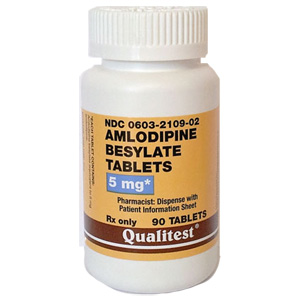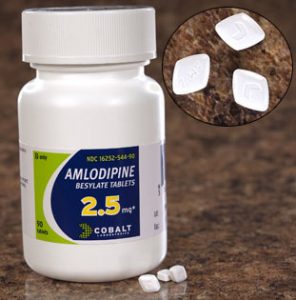How Amlodipine and Streptomycin works (mode of action)?
Amlodipine is known as calcium channel blocker also known as calcium antagonist. Amlodipine targets L-type calcium channel and therefore inhibits the calcium ion influx across the cell membrane. Inside the cell, calcium molecules act as messenger that binds to calmodulin protein (calcium binding signalling protein) and make calcium -calmodulin complex.
Formation of calcium-calmodulin complex results in downstream activation of myosin light chain kinase (MLCK). Myosin light chain kinase play an important role in muscle contraction through phosphorylation of regulatory light chain subunit of myosin.
Since, Amlodipine inhibits calcium ion influx across the cell membrane this results in the decreased activation of myosin light chain kinase (MLCK) and therefore decreases contraction of arterial smooth muscle cells. Reduction in muscle contraction of arteries ultimately cause vasodilation; widening of blood vessels.
Once vasodilation occurs it ultimately cause reduction or lowering the blood pressure. Besides this, it is also suggested that Amlodipine can inhibits or reduced the activity of an important enzyme in vascular smooth muscle i.e. carbonic anhydrase I. Inhibition of carbonic anhydrase I may results in an increase in pH and therefore may influence intracellular influx of calcium.
Streptomycin basically belongs an aminoglycoside class of antibiotic that preferentially acts through inhibition of protein synthesis pathway. Aminoglycoside primarily binds with 30S ribosomal subunit and therefore misguided tRNA, which results in disruption of the initiation and elongation steps of protein synthesis.
Similar to other aminoglycoside, Streptomycin is also a potent protein synthesis inhibitor. Streptomycin binds irreversibly with 30S subunit of the bacterial ribosome (small 16S rRNA and a single amino acid of protein S12).
This results in interference with decoding site and wobbles base pairing of formyl-methionyl-tRNA in the anticodon of tRNA. As a result, the overall ribosomal-mRNA complex (initiation complex) becomes unstable and non functional and defective protein synthesis.
Can both Amlodipine and Streptomycin be taken together in combination?
Yes, Amlodipine can be used in combination with Streptomycin for the treatment of drug resistance bacterial diseases. Streptomycin is basically a medicinal and bacteriologic agent that inhibits protein synthesis in gram negative bacteria. The Streptomycin is also used as a pesticide, to inhibit the growth and development of fungi, bacteria,and algae.
Generally, Amlodipine is a cardiovascular drug that is used for the treatment of high blood pressure. However, Amlodipine also exhibits remarkable antibacterial action against bacterial strains belonging to both gram positive and gram negative genera both in vitro as well as in vivo against a mouse-virulent bacterium.
Based on such findings, several studies were undertaken to determine the efficacy of Amlodipine (non-antibiotic drug) in combination of Streptomycin antibiotic.
Results of these studies have revealed that Amlodipine and Streptomycin show marked synergism in combination, compared with their individual effects. Currently, non-antibiotics, Amlodipine (AML) is the most promising helper compound in combination therapy to combat drug resistance in bacterial diseases.
Safety and precautions while taking Amlodipine : Streptomycin combination
- The use of Amlodipine alone or in combination is strictly contraindicated if someone is hypersensitive or allergic to any of the components/ingredients of Amlodipine.
- Use of Amlodipine is not recommended hypotension patients (low blood pressure) and in case of aortic stenosis (a disease which is characterized by contraction of the left ventricle outlet of the heart) and liver disease.
- Amlodipine is not prescribed or contraindicated to use in combination with vasodilator ad calcium channel blockers agents.
- Amlodipine is not prescribed or contraindicated to use in combination with CYP3A4 inhibitors ( ketoconazole , clarithromycin) due to there effects on plasma concentration or retention of Amlodipine.
- Amlodipine is not prescribed or contraindicated to use in combination with antihypertensive drugs, antifungal agents ( itraconazole and voriconazole) and macrolide antibiotics ( sulfisoxazole).
- It is usually prescribed to avoid high-salt diet or use diet as prescribed by your doctor otherwise follow usual diet.
- Consult your doctor regarding the use of grapefruit products.
- Before taking Amlodipine, and Streptomycin in combination it is advisable to inform your pharmacist about your medical history most notably if you have any kind of history of liver disease.
- Grapefruit or grapefruit juice should be avoided because it may increase the level of active Amlodipine in the blood which may cause toxicity.
- It is important to consult with your doctor in case if you are taking any herbal products and prescription and non-prescription medications.
- Tell your doctor immediately if you feel symptoms after stopping Streptomycin medication such as muscle weakness, new signs of infections, change in the amount of urine, persistent diarrhea, bleeding/bruising, fast heartbeat, , unusual tiredness.
- In case if you are using Streptomycin injection, inform immediately your pharmacist if you are hypersensitive or allergic to aminoglycoside antibiotics (e.g., tobramycin, gentamicin); or if you have any other allergies.
“Can you take gabapentin with oxcarbazepine?“
“Is perindopril with amlodipine safe for the treatment of hypertension?“



